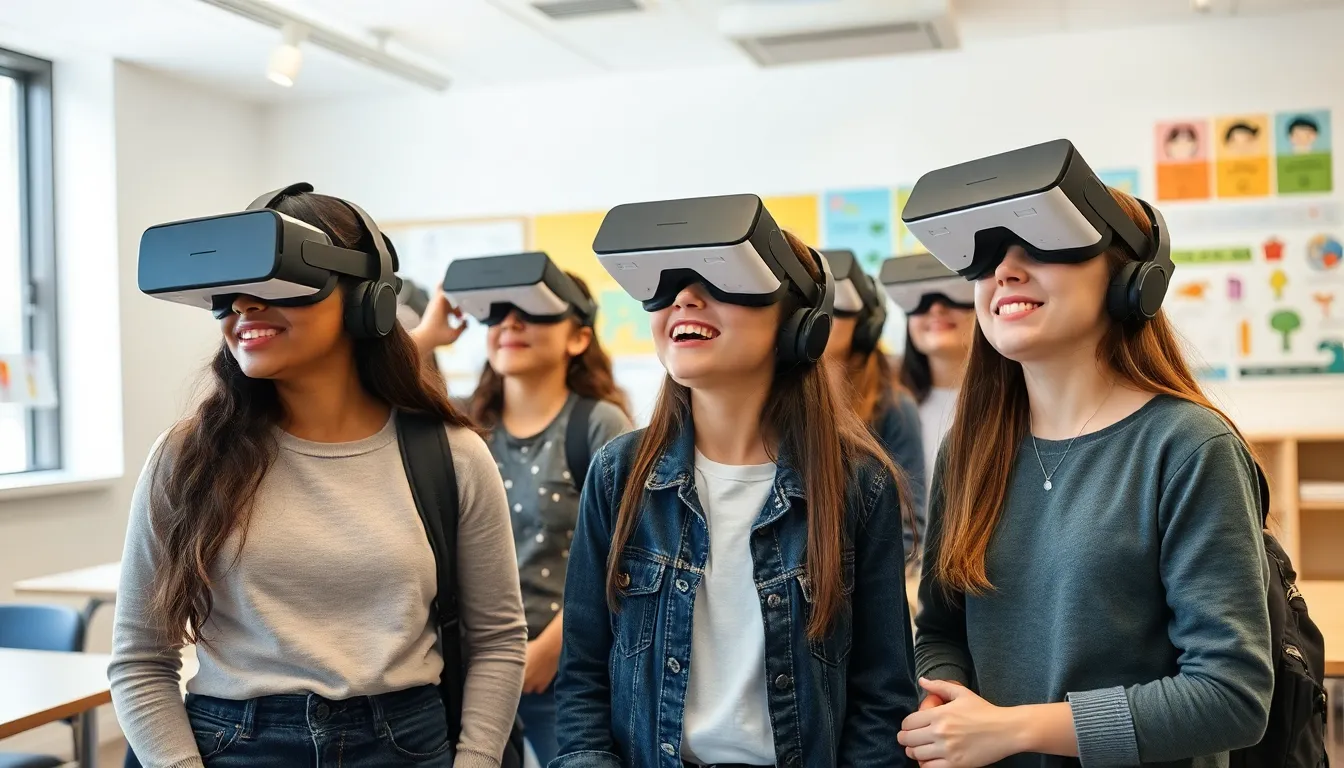In a world where smartphones can practically order dinner for you, it’s no surprise that learning has stepped into the future with a bang. Emerging learning technologies are shaking things up, making education more engaging and accessible than ever. Imagine a classroom where virtual reality whisks students away to ancient Rome or where artificial intelligence tailors lessons to each learner’s pace—sounds like a sci-fi movie, right?
Table of Contents
ToggleOverview of Emerging Learning Technologies
Emerging learning technologies significantly reshape how education is delivered and experienced. Virtual reality (VR) creates immersive environments that enhance learner engagement. Students can explore complex concepts in 3D settings, promoting deeper understanding.
Artificial intelligence (AI) personalizes learning experiences. It analyzes student performance data, allowing for tailored content that matches individual needs. With AI tools, educators can quickly identify knowledge gaps and adjust instruction accordingly.
Gamification integrates game design elements into learning. This approach boosts motivation and retention by making education more interactive. For example, earning points and completing challenges can lead to increased participation among students.
Mobile learning facilitates access to educational resources anytime, anywhere. This flexibility supports ongoing learning and allows for diverse modalities, from videos to interactive quizzes. Learners benefit from being able to engage with content beyond traditional classroom settings.
Adaptive learning technologies continuously adjust content and assessments based on student input. Such systems help learners progress at their own pace and ensure mastery before advancement. Immediate feedback promotes a deeper grasp of subject matter.
Collaborative tools foster communication and teamwork among students. Their design encourages peer interaction and knowledge-sharing, which enriches the educational experience. Platforms that support discussion and project collaboration exemplify this trend.
Investments in blockchain technology provide secure and verifiable records of achievements. This innovation enhances the credibility of educational credentials, simplifying verification for employers and institutions. Overall, emerging learning technologies present vast opportunities to revolutionize the educational landscape.
Types of Emerging Learning Technologies

Emerging learning technologies are transforming educational practices. These innovations enhance engagement, accessibility, and personalization.
Virtual Reality (VR)
Virtual reality offers immersive learning experiences through 3D simulations. Students interact with complex concepts in a controlled environment, deepening their understanding. This technology facilitates experiential learning, allowing individuals to practice skills safely. For instance, medical students can perform virtual surgeries, gaining practical knowledge in a risk-free setting. VR technology promotes active participation, making lessons more engaging and memorable.
Augmented Reality (AR)
Augmented reality overlays digital information onto the physical world, enriching learning experiences. Learners can visualize complex topics by interacting with virtual elements integrated into real-life contexts. For example, AR applications enable students to explore historical sites or scientific concepts interactively. This immersive approach enhances retention and understanding, as it connects theoretical knowledge to practical applications. The accessibility of AR on mobile devices makes this technology especially appealing for diverse learning environments.
Artificial Intelligence (AI)
Artificial intelligence personalizes learning by analyzing student performance data. This technology tailors educational content to meet individual needs, ensuring a customized experience. AI-driven platforms offer adaptive assessments and feedback, enhancing mastery at personalized paces. Additionally, intelligent tutoring systems provide support and resources based on students’ unique learning paths. By streamlining content delivery and engagement, AI fosters a more effective educational experience.
Mobile Learning Applications
Mobile learning applications offer flexible access to educational resources anytime, anywhere. Students can engage with materials on their smartphones or tablets, facilitating learning beyond traditional classrooms. These applications support various learning modalities, catering to different preferences. Features like interactive quizzes, video tutorials, and discussion forums enhance collaboration and engagement. The convenience of mobile platforms encourages continuous learning, promoting a culture of knowledge acquisition.
Impact on Education
Emerging learning technologies significantly reshape education, making it more engaging and accessible.
Enhancing Engagement and Motivation
Virtual reality (VR) creates immersive spaces where students interact with content in dynamic ways. Augmented reality (AR) transforms traditional lessons, allowing learners to visualize concepts in real-world settings. Gamified elements add a competitive edge, encouraging students to participate actively. Interactive challenges foster collaborative efforts, enhancing social learning experiences. Creative digital storytelling captivates learners, making complex information more relatable and fun. These engaging tools motivate students to take ownership of their learning journeys, leading to improved outcomes.
Personalizing Learning Experiences
AI-driven platforms assess individual student performance, offering customized content that addresses specific needs. Tailored learning paths allow educators to refine instructional strategies based on real-time data. Adaptive assessments adjust difficulty levels, ensuring that students are consistently challenged without feeling overwhelmed. Intelligent tutoring systems provide immediate feedback, guiding learners through complex subjects at their own pace. This personalized approach helps students build confidence and fosters a deeper understanding of the material, enhancing overall success.
Improving Accessibility
Mobile learning applications break down barriers by enabling access to resources anytime and anywhere. Students with disabilities benefit from adaptive tools that cater to various learning needs and styles. AR enhances physical learning environments by providing digital overlays that support all learners. Open educational resources create equitable opportunities for students, regardless of their geographical location. Investments in blockchain technology strengthen the credibility of educational credentials while ensuring secure records. Each of these advancements plays a pivotal role in democratizing learning and creating inclusive educational experiences.
Challenges and Considerations
Emerging learning technologies present unique challenges along with their benefits. Understanding these hurdles helps address potential limitations and maximizes effectiveness.
Implementation and Integration Issues
Implementing new technologies within existing educational frameworks poses significant challenges. Institutions often face budget constraints that limit resource allocation for hardware and software. Additionally, compatibility with legacy systems might complicate integration efforts. Proper planning and a clear strategy are essential for successful deployment. Educators and administrators must collaborate to ensure alignment between technology goals and curriculum needs. Pilot programs can also aid in identifying potential obstacles before widespread adoption.
Privacy and Security Concerns
Privacy and security issues remain a top priority when incorporating emerging technologies. Students’ personal data often requires protection from unauthorized access and breaches. Educational institutions must comply with regulations such as FERPA, ensuring students’ information remains confidential. Furthermore, as AI and data analytics become central to personalized learning, guidelines must dictate data collection, storage, and usage practices. Continuous monitoring and risk assessments help maintain secure educational environments while building trust with students and parents.
Teacher Training and Support
Effective teacher training proves critical to leveraging cutting-edge technologies in classrooms. Training programs should encompass not only technical skills but also pedagogical approaches for integrating these tools. Accessibility to ongoing professional development fosters confidence and competency among educators. Support networks that include mentorship and peer collaboration enhance teachers’ abilities to adapt to new learning environments. Creating a culture of continuous learning allows educators to embrace innovation and effectively meet the diverse needs of their students.
Future Trends in Emerging Learning Technologies
Emerging learning technologies are set to transform education further in the coming years. Anticipated advances include greater integration of immersive experiences and data-driven learning models.
Predictions for the Next Decade
Experts predict exponential growth in artificial intelligence and machine learning in education. Enhanced personalization through adaptive learning algorithms will cater to individual learning paths, improving student engagement. Virtual reality and augmented reality may become more commonplace, allowing students to experience subjects firsthand. Collaborative technologies will further streamline communication among students and educators, fostering teamwork across various settings. Educational gamification is also likely to evolve, making learning more interactive and enjoyable. Ultimately, these trends will redefine classroom dynamics and focus on holistic approaches to student learning and development.
The Role of Data Analytics
Data analytics plays a crucial role in shaping future educational experiences. Schools and institutions can leverage insights from student performance data to inform lesson planning and curriculum development. Predictive analytics may help identify students at risk, enabling timely interventions and support. Furthermore, ongoing assessments through data analysis will promote continuous learning and growth, ensuring learners stay on track. Integrating learning analytics with emerging technologies will enhance the personalization of educational content, meeting diverse needs effectively. Effective use of data will drive decision-making processes, making education more responsive and student-centered.
Emerging learning technologies are revolutionizing education by making it more engaging and personalized. The integration of VR, AR, AI, and other innovations is not just enhancing accessibility but also transforming how students interact with content. As these technologies continue to evolve, they promise to create a more dynamic and inclusive educational landscape.
Addressing the challenges of implementation and ensuring proper training for educators will be crucial for maximizing the potential of these advancements. By focusing on security and adapting to the needs of diverse learners, institutions can harness the power of these tools to foster a more effective learning environment. The future of education looks bright with the continued integration of these technologies.


